Quantum Random Number Generators for Stronger Security (2025)
In an era defined by increasingly sophisticated cyber threats, the integrity of cryptographic systems is paramount. At the heart of these systems lie Random Number Generators (RNGs), the unsung heroes responsible for creating the unpredictable keys and parameters that secure our digital lives. However, traditional RNGs are facing unprecedented challenges. As we advance into 2025, the limitations of classical RNGs become more glaring, highlighting the urgent need for a quantum leap in security: Quantum Random Number Generators (QRNGs).
The Vulnerabilities of Classical RNGs
Classical RNGs, also known as Pseudo-Random Number Generators (PRNGs), rely on deterministic algorithms to produce sequences that appear random. While these algorithms can generate numbers quickly and efficiently, their deterministic nature makes them vulnerable. Given enough information about the algorithm and its initial state (the ‘seed’), an attacker can predict the entire sequence of numbers.
Several attack vectors exploit these vulnerabilities:
- Seed Prediction: Attackers can attempt to discover or predict the seed value, allowing them to replicate the generated sequence.
- Algorithmic Weaknesses: Some PRNG algorithms have inherent biases or patterns that can be exploited to predict future outputs.
- State Compromise: If an attacker gains access to the internal state of the PRNG, they can compromise the entire sequence.
These vulnerabilities pose a significant risk to cryptographic applications, including encryption, authentication, and digital signatures. As computational power increases, particularly with the advent of quantum computing, the ability to crack classical RNGs becomes ever more feasible.
The Quantum Solution: Introducing QRNGs
Quantum Random Number Generators (QRNGs) offer a fundamentally different approach to randomness. Instead of relying on algorithms, QRNGs harness the inherent randomness of quantum mechanics to generate truly unpredictable numbers. Quantum mechanics dictates that certain physical processes, such as radioactive decay or photon behavior through a beamsplitter, are inherently random and cannot be predicted, even in principle.
Here’s how QRNGs work:
- Quantum Source: QRNGs start with a quantum source, such as a laser or a radioactive material.
- Random Process: They exploit a quantum process, like photon arrival times or quantum tunneling, that exhibits true randomness.
- Detection and Measurement: Specialized detectors measure the outcome of the quantum process.
- Random Number Generation: The measurements are converted into a stream of random numbers.
Benefits of Quantum Random Number Generators
QRNGs offer several key advantages over classical RNGs:
- True Randomness: QRNGs generate numbers based on the laws of quantum physics, ensuring genuine unpredictability.
- Unpredictability: Unlike PRNGs, QRNGs are immune to seed prediction and algorithmic weaknesses. Their output cannot be predicted, even with complete knowledge of the system.
- Enhanced Security: By providing a source of high-quality, unpredictable random numbers, QRNGs strengthen cryptographic systems against a wide range of attacks.
- Future-Proofing: As quantum computers become more powerful, classical cryptographic algorithms will become vulnerable. QRNGs offer a path to quantum-resistant security.
Applications of QRNGs
QRNGs have a wide range of applications across various industries:
- Cryptography: Secure key generation, encryption, and digital signatures.
- Cybersecurity: Protecting sensitive data and preventing unauthorized access.
- Financial Services: Generating random numbers for trading algorithms and risk management.
- Gaming: Creating truly random outcomes in online games and lotteries.
- Scientific Simulations: Providing random numbers for Monte Carlo simulations and other scientific applications.
Challenges and Future Directions
Despite their immense potential, QRNGs face certain challenges:
- Cost: QRNGs can be more expensive than classical RNGs, particularly high-performance devices.
- Speed: Some QRNG implementations may have lower throughput than classical RNGs.
- Integration: Integrating QRNGs into existing systems may require significant engineering effort.
Future research and development efforts are focused on addressing these challenges. Key areas of focus include:
- Miniaturization: Developing smaller, more compact QRNG devices.
- Cost Reduction: Lowering the cost of QRNG technology through improved manufacturing processes.
- Performance Enhancement: Increasing the speed and throughput of QRNGs.
- Standardization: Developing industry standards for QRNGs to ensure interoperability and security.
Conclusion
As we navigate the increasingly complex threat landscape of 2025 and beyond, Quantum Random Number Generators will play a critical role in securing our digital infrastructure. By harnessing the power of quantum mechanics, QRNGs offer a truly random and unpredictable source of numbers, providing enhanced security against evolving cyber threats and future-proofing our cryptographic systems for the quantum age. While challenges remain, ongoing research and development efforts are paving the way for widespread adoption of QRNG technology, ensuring a more secure and resilient digital future.




